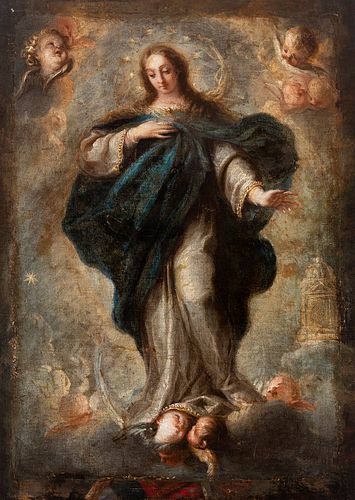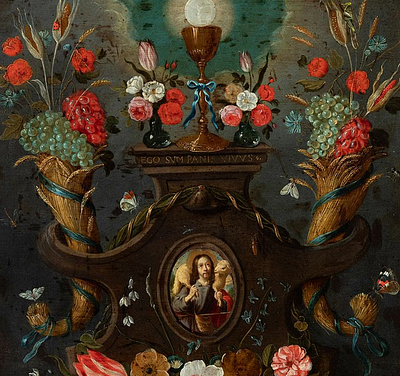Master from Madrid; last third of the 17th century. "Purísima Concepción". Oil on canvas. Relining.
Lot 43
About Seller
Setdart Auction House
Carrer Aragó 346
Barcelona
Spain
Setdart Subastas was born in 2004 and is currently the first online art auction in Spain with solidity, prestige and reliability guaranteed by our more than 60,000 users. Setdart has a young, dynamic and enterprising team ready to successfully manage the purchase and sale of art works through custom...Read more
Estimate:
EUR€3,000 - EUR€4,000
$3,157.89 - $4,210.53
Absentee vs Live bid
Two ways to bid:
- Leave a max absentee bid and the platform will bid on your behalf up to your maximum bid during the live auction.
- Bid live during the auction and your bids will be submitted real-time to the auctioneer.
Bid Increments
| Price | Bid Increment |
|---|---|
| EUR€0 | EUR€10 |
| EUR€200 | EUR€25 |
| EUR€500 | EUR€50 |
| EUR€1,000 | EUR€100 |
| EUR€3,000 | EUR€200 |
| EUR€5,000 | EUR€500 |
| EUR€10,000 | EUR€1,000 |
| EUR€20,000 | EUR€2,000 |
| EUR€50,000 | EUR€5,000 |
About Auction
By Setdart Auction House
Sep 21, 2021
Set Reminder
2021-09-21 10:00:00
2021-09-21 10:00:00
America/New_York
Bidsquare
Bidsquare : 21st September - ARAS JÁUREGUI Private Collection - Old Masters, 19th & 20th Century
https://www.bidsquare.com/auctions/setdart-auction-house/21st-september---aras-j-uregui-private-collection---old-masters-19th-20th-century-7429
Setdart Auction House sofia@setdart.com
Setdart Auction House sofia@setdart.com
- Lot Description
Master from Madrid; last third of the 17th century. "Purísima Concepción". Oil on canvas. Relining. It presents repainting, faults and old extensions. Measurements: 81 x 57,5 cm. The representation of Mary as Immaculate with the figure of full body, standing on a lunar crescent, which is arranged in the centre of the composition, is a common representation in the history of art. Medieval Christianity passionately debated the belief that Mary was conceived without stain of original sin. Some universities and corporations vowed to defend this privilege of the Mother of God, several centuries before the First Vatican Council defined the dogma of faith in 1854. At the end of the Middle Ages the need arose to give iconographic form to this idea, and the model of the Apocalyptic Woman of Saint John was taken, maintaining some elements and modifying others (the Apocalyptic Woman is pregnant, but not the Immaculate). The definitive image came to fruition in the 16th century, apparently in Spain. Following a Valencian tradition, the Jesuit Father Alberro had a vision of the Immaculate Conception and described it to the painter Juan de Juanes so that he could depict it as faithfully as possible. It is an evolved iconographic concept, sometimes associated with the theme of the Coronation of the Virgin. Mary is shown standing, dressed in a white tunic and blue cloak, her hands crossed on her chest, with the moon at her feet (in memory of Diana's chastity) and treading on the infernal serpent (symbol of her victory over Original Sin). Around his head, like a halo, he wears the twelve stars, symbolic of fullness and alluding to the twelve tribes of Israel. Most of these images are accompanied in the painting by the Marian symbols of the litanies and psalms. Many artists worked on this theme, the works of Mateo Cerezo (Burgos, 1637 - Madrid, 1666) and José Antonílez (Madrid, 1635-1675) being particularly noteworthy for the large number of works he dedicated to the Immaculate Conception, of which around twenty have been preserved, three of them signed in the Museo del Prado. He succeeded in creating his own iconographic type of extreme elegance and refinement, in which the Virgin appears with a concentrated countenance, sweetly self-absorbed despite the busy group of angels surrounding her. The Madrid school emerged around the court of first Philip IV and then Charles II, and developed throughout the 17th century. Analysts of this school have insisted on considering its development as a result of the binding power of the court; what is truly decisive is not the place of birth of the different artists, but the fact that they were educated and worked around and for a nobiliary and religious clientele based next to the royals. This allowed and encouraged a stylistic unity, which gradually developed into a more autochthonous Baroque language linked to the political, religious and cultural conceptions of the Habsburg monarchy, before dying out with the first outbreaks of Rococo. The techniques most commonly used by these painters were oil and fresco. Stylistically, they started out from a naturalism with a notable capacity for synthesis to lead opportunely to the allegorical and formal complexity characteristic of the decorative Baroque. These artists showed a great concern for the study of light and colour, as we can see here, initially emphasising the interplay between extreme tones characteristic of tenebrism, which were later replaced by a more exalted and luminous colouring. They received and assimilated Italian, Flemish and Velázquez influences.
- Shipping Info
-
In-house shipping available. Please inquire at admin@setdart.com.
-
- Buyer's Premium



 EUR
EUR CAD
CAD AUD
AUD GBP
GBP MXN
MXN HKD
HKD CNY
CNY MYR
MYR SEK
SEK SGD
SGD CHF
CHF THB
THB

















